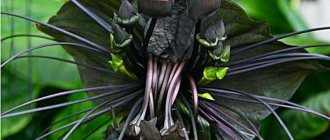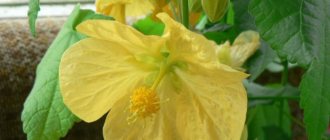In folk tales, signs and beliefs, white flowers are associated with purity, innocence, happiness and joy. It is not for nothing that the bride’s bouquet is made up mainly of white flowers. Landscape designers use white flowering plants to visually expand the space and create a benign, festive atmosphere that promotes relaxation and rest.
In natural conditions, there are many plants with white flowers, but not all of them are suitable for growing indoors. Thanks to the efforts of modern geneticists and breeders, today everyone can choose indoor plants that bloom white, but differ in size, shape of leaves, corolla, flower petals and their number.
White Bauhinia
This flower is popularly called the orchid tree because it is very similar to the popular orchids. Under natural conditions, Bauhinia can be found in tropical forest zones, but it also tolerates indoor conditions. The shape of the snow-white flowers resembles the fluttering of butterflies. You can admire the flowers during the day, but at night they close.
Basic care elements:
- A tropical guest should be placed in a warm room with plenty of lighting and without sudden changes in temperature.
- In winter, the plant needs rest with the temperature dropping to 12 degrees.
- The flower should be brought out of dormancy gradually to avoid burns to the young leaves.
- An important maintenance condition is irrigation - it should be plentiful in the summer season and supportive during the dormant period in winter. It is important to observe the interval between watering and allow the soil to dry out.
Bauhinia is not one of the capricious beauties, so it is enough to follow the basic rules and during the flowering period the plant will delight you with a snow-white blanket of fluttering flowers.
Pittosporum fragrant
Umbrella inflorescences of white pittosporum stars emit a rich, sweetish odor. Flowering begins in the 4th year after planting and lasts from March to July.
The plant needs sufficient light for the formation of buds and rich foliage color. Afraid of heat and sudden temperature changes. Has good immunity.
Popular varieties:
- Nana - a large number of shoots with glossy dark green leaves;
- Variegate is a spectacular plant with soft green leaves dotted with white spots.
In winter, this flower should be kept indoors without drafts at a temperature of 10-14°C.
Arthropodium white
Arthropodium is a guest from New Zealand. It has purple and bronze elongated grassy leaves. During flowering, the falling shoots are densely covered with elongated flowers and the plant resembles a blooming Christmas tree.
Basics of care:
- Arthropodium white prefers warm sunny places, protected from drafts. The light should be bright enough, but diffused. Direct sunlight has a detrimental effect on the well-being of the plant.
- The flower should be watered moderately; even slight waterlogging of the soil should not be allowed. But Arthropodium will respond with gratitude to a refreshing shower. In winter, the plant should be watered extremely carefully and sparingly.
- During the period of active growing and flowering, the plant needs to be fed regularly. The interval between the application of complex mineral fertilizers is 14 days.
In order for Arthropodium white to please with flowering for a long time, you need to follow the watering and fertilizing regime.
Selenicereus
This plant belongs to the genus of cacti that came from the forest and rocky areas of South America. The body of Selenicereus is represented by thin multi-ribed flowing shoots, on which aerial roots-trailers are formed, with the help of which the plant is strengthened on any supports.
In mid-spring, flower buds begin to form on the shoots. They are small fluffy balls that gradually grow and turn into huge buds. Flowers up to 35 cm in diameter open in the evening, filling the space with a thick vanilla aroma. The flowers consist of multiple white petals with gilded sepals.
Flowering lasts only one night.
How to properly care for the plant:
- Selenicereus prefers brightly lit places and easily tolerates the influence of direct sunlight, but reacts painfully to the slightest drafts and sudden temperature changes.
- Watering should be carried out as needed - after the soil has completely dried. The plant does not need spraying, but periodically you should give it a light warm shower to wash off the dust.
- Selenicereus should be planted in a fertile, but light and loose soil mixture. Soil is good for cacti.
Houseplant with white flowers - from gardenia to eucharis.
Hello beauty lovers. Today on the women's site we will talk about indoor plants with white flowers.
Beautiful flowering plants have always been especially popular among flower growers and simple connoisseurs of beauty.
And recently, flowers have begun to play the role of the finishing touch in interior design. Combinations of two colors have come into fashion: yellow and brown, red and black, but the most sophisticated solution is the interior in white and green tones.
No designer's imagination can surpass the harmony and perfection of a green indoor plant with white flowers and indoor plants with large leaves, beautiful by nature.
Gardenia is a low evergreen shrub of the Rubiaceae family, native to South Africa, India, and China. In nature, there are up to 250 species of this small tree.
Houseplant with white flowers – gardenia
The most popular among gardeners is the jasmine gardenia (Gardenia jasminoides). A bush with dark green glossy leaves, quite large, with depressed veins.
The flowers are white with a cream tint, collected in corymbose inflorescences, each containing 4–6 pieces or single, double and semi-double, 5–7 cm in diameter. The aroma is sweet, intense, with notes of jasmine.
At home, gardenia grows up to 45–50 cm. Flowering begins in July and continues until the end of October.
Gardenia is very demanding; it must be taken care of exclusively according to all the rules. But there are not many of them:
- slightly acidic or neutral soil;
- watering in a timely manner, without excess;
- mandatory spraying of water around the bush;
- temperature – strictly within the range of 16 to 22°C;
- a bright place, but at the same time protected from direct rays of the sun;
- After flowering, formative pruning is necessary.
Jasmine belongs to the olive family, common in Asia, Transcaucasia and northern China. Flowers of different species are white , yellow, and pink.
Houseplant with white flowers – jasmine
Jasmine (Jasminum officinale) has exceptionally white fragrant flowers - the most common species for growing at home.
The shape is a liana with gradually lignifying stems, the leaves are pinnate, the flowers are white, collected 5-6 in a racemose inflorescence. The diameter of the flowers is 2.5 cm. The plant blooms all summer, but only after reaching maturity.
Jasmine is quite unpretentious, he responds gratefully to care, and he doesn’t need much:
- a brightly lit place with shading during the hottest hours;
- watering is moderate, the soil should always be moist;
- regular spraying of leaves;
- The room temperature is moderate, jasmine prefers cool wintering (up to +7°C), and in the summer it prefers being in the fresh air;
- the soil for young plants is clay-turf with leaves and sand, for adults – clay-turf;
- time for transplantation is March.
White zephyranthes (Zephyranthes candida) is a member of the amaryllis family, common in Central and South America.
In nature, there are up to 40 species of zephyranthes. This plant is bulbous, perennial, with small round bulbs (3–4 cm in diameter).
Houseplant with white flowers – Zephyranthes alba
The leaves are narrow, belt-shaped, up to 30 cm long, 0.5 cm wide. Each peduncle (about 20 cm long) has a single flower. The perianth is funnel-shaped, about 6 cm in diameter, white on the inside, pinkish on the outside.
Blooms from July to October. For its special straight and tall peduncle, the plant was popularly called an upstart.
In order for the plant to enjoy normal growth and abundant flowering, several conditions must be met:
- the optimal temperature for zephyranthes is 17–23°C during the growing season, during the dormant period – 12–14°C;
- watering is moderate; if during the dormant period the plant begins to lose leaves, then watering should be stopped and the bulbs should be kept dry; if leaves remain, water occasionally;
- a well-lit sunny place, zephyranthes is not afraid of bright light and direct rays of the sun;
- in summer, in a room with dry air, you need to periodically spray the plant;
- replanting is often not recommended; this should be done in the spring, no more than once every 3–4 years or when the pot becomes too small;
- the soil should contain equal parts: clay-turf soil, leaf soil, peat, sand and humus.
Spathiphyllum (Spatiphyllum) - from the aroid family, it is also called the houseplant of female happiness. Distributed in South America, Polynesia, East Asia.
What houseplant is necessary for women's happiness?
It has a unique feature: under favorable conditions, flowering continues all year round. And for the first time, the flowering period begins at a very young age - at 6-7 months.
Spathiphyllum profusely flowering usually has an underground creeping stem and oblong-lanceolate leaves pointed at the end. Its peduncle reaches 25 cm in height, the inflorescences are cobs with a slightly concave veil of pure white color.
This indoor plant with white flowers requires favorable conditions. Here is a short list of them:
- loves warmth, the optimal range is from 22 to 26 ° C, occasionally necessary periods of rest at a lower temperature (14 ° C) lasting 2-3 weeks;
- it is advisable to isolate the plant from drafts;
- the lighting is bright, but at the same time diffused, shading from direct rays of the sun, additional lighting in winter;
- watering abundantly, more moderate in winter;
- regular spraying, flowers and buds should be covered,
- leaves need to be washed;
- The soil composition should contain two parts of turf soil and one part each of leaf soil, peat soil, humus soil and sand.
Eucharis , or otherwise - Amazonian lily. A member of the amaryllis family, native to tropical America. Eucharis is a bulbous plant with wide, leathery, dark green leaves.
Houseplant with white flowers – Eucharis.
The peduncle is tubular, tall, the buds are located at its top. Snow-white, fragrant flowers are collected in an umbrella of 3-6 pieces; their shape resembles a daffodil. It blooms twice a year: from October to cold winter and in spring. The dormant period continues from March to August.
Eucharis is a rather unpretentious plant; even with a minimum of care, it blooms on time. Let's take a look at this minimum:
- At least three bulbs should be planted in one pot;
- Eucharis loves warmth, at least 16–18°C even in winter;
- he needs diffused light, partial shade, the bright rays of the sun are destructive;
- watering abundantly, during the dormant period you can practically not water, but do not let the soil dry out;
- In summer, regular spraying is required;
- the leaves must be washed occasionally with a sponge;
- replant every 3–4 years during the dormant period, carefully preserving the lump of earth;
- very nutritious soil (a mixture of fibrous turf with a small amount of peat and leaf soil).
This is not a complete list of indoor plants with white flowers.
I wish you success in growing and caring for indoor flowers! You can read how to properly care for them in my article at this link.
Phalaenopsis white
This simplest and most unpretentious representative of the orchid family is the most popular. White phalaenopsis is able to bloom almost the whole year, because the flower buds bloom gradually, and each snow-white butterfly flower lives from two to three months. The flower can form up to four peduncles, each with 6-12 buds.
Phalaenopsis has a short stem and long, oval, densely textured leaves that grow from a single point. The orchid does not strive to increase green mass and, when releasing a new leaf, it sheds one of the old ones. Therefore, more than six leaves can rarely be observed on a plant. The peculiarity of the orchid is that it produces fleshy aerial roots of a greenish flower, which can even form in the axils of the leaves.
The average lifespan of Phalaenopsis is about seven years, during which time the flower requires quality care:
- You can place the orchid in the back of the room, with enough diffused light. The optimal length of daylight is 14 hours. Therefore, you should take care of artificial lighting in advance. The suitable temperature for keeping the flower is 23-25 degrees.
- Phalaenopsis must be watered correctly so that drops of water do not fall on the leaves, especially in the center of the rosette. Excessive moisture causes the plant to rot. Irrigation procedures are carried out using water mist or the immersion method, when the flower collects the required amount of moisture through the drainage hole. If water does get into the outlet, it must be dried with a paper napkin.
- The butterfly orchid needs regular feeding throughout the season. Special fertilizers are applied 30 minutes after watering. When choosing a fertilizer, you should pay attention to its composition; if the fertilizer contains components that stimulate the formation of buds, then only healthy and developed specimens can be fed with it.
- The soil for orchids must contain the bark of coniferous trees. The plant is replanted every two to three years or when the roots completely entwine the earthen ball and begin to rise above the pot. The procedure is carried out after flowering has ended.
Caring for such a “snow white” is quite troublesome, because she is capricious. But, if Phalaenopsis likes the conditions, it will reward you with lush and long-lasting flowering.
Stephanotis profusely flowering
This is the only type of stephanotis that is grown indoors. At the same time, its weak stems need support.
The plant blooms from May to the end of summer, sometimes again in September. Its delicate waxy flowers of cream, white or purple color have a strong, pleasant scent.
Stephonatis does not like drafts and overheating, and it may not bloom in a pot that is too spacious. Prefers rooms with high air humidity and diffused lighting. Loves loose neutral soil. Needs spraying. Picky about water quality.
Zephyranthes
Zephyranthes is popularly called an upstart, because its flower stalks develop very quickly and often appear before the leaves. In its homeland, the flower begins to bloom after seasonal heavy rains brought by the western wind, so the name of the plant is literally translated as “flower of the western winds.”
Zephyranthes flowers appear singly and look like white lilies or crocuses.
Zephyranthes can rarely be found on windowsills, although this plant is absolutely unpretentious:
- It is better to place the flower in well-lit rooms on the southwest side of the house. And for the summer season, the upstart can be moved to the veranda.
- The optimal temperature in summer is 29-23 degrees, and in winter – 11-13 degrees.
- Irrigation procedures should be regular and plentiful. But you should not allow water to stagnate in the pot. After flowering, watering should be reduced and the plants should be allowed to drink only after the top layer of soil has dried.
- Fertilizing should be applied during the growing season and flowering in the form of a solution of complex mineral fertilizers at intervals of two weeks.
- The plant is replanted annually, because many baby bulbs are formed during the season and Zephyranthes becomes cramped in the pot. The procedure should be carried out at the beginning of the rest period.
Hoya fleshy
Hoya fleshy has glossy foliage and beige, waxy, star-shaped flowers with an intense, sweet scent. It blooms in early summer, producing nectar that drips from each petal.
Hoya is unpretentious and tolerates cold and heat well. Loves well-lit places and loose, drained soil. Sensitive to dampness. Afraid of mealybugs.
This flower needs regular feeding with fertilizers for epiphytic plants. You can replant at any time of the year.











